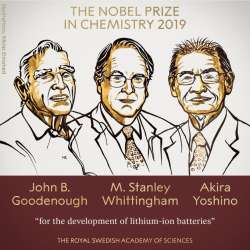Nobel Prize in Chemistry awarded to John Goodenough, Stanley Whittingham and Akira Yoshino
The 2019 Nobel Prize in Chemistry has been awarded to John B. Goodenough, M. Stanley Whittingham and Akira Yoshino “for the development of lithium-ion batteries.

The 2019 Nobel Prize in Chemistry has been awarded to John B. Goodenough, M. Stanley Whittingham and Akira Yoshino “for the development of lithium-ion batteries. The prize amount of 9 million Swedish krona will be shared equally between the Laureates.
Nobel Prize in Chemistry announced: How they created a rechargeable world
Nobel Prize in Chemistry winners John B. Goodenough, M. Stanley Whittingham and Akira Yoshino have been awarded the prestigious award for developing the lithium-ion battery. In fact, this lightweight, rechargeable and powerful battery is now used in everything from mobile phones to laptops and electric vehicles. It can even store significant amounts of energy from solar and wind power, making possible a fossil fuel-free society. From mobile phones to laptops and electric vehicles, lithium-ion batteries are used in everything. It is lightweight, rechargeable and powerful battery.
Nobel Prize in Chemistry: How are lithium ion batteries used
Lithium ion batteries are used across the globe. It powers the portable electronics that we use to communicate, work, study, listen to music and search for knowledge. Lithiumion batteries have also enabled the development of long-range electric cars and the storage of energy from renewable sources, such as solar and wind power.
Nobel Prize in Chemistry: Stanley Whittingham's contribution
Stanley Whittingham worked on developing methods that could lead to fossil fuel-free energy technologies. He started to research superconductors and discovered an extremely energy-rich material, which he used to create an innovative cathode in a lithium battery.
Nobel Prize in Chemistry: John Goodenough's contribution
It was John Goodenough who predicted that the cathode would have even greater potential if it was made using a metal oxide instead of a metal sulphide. In 1980, John Goodenough demonstrated that cobalt oxide intercalated lithium ions can produce as much as four volts. This was a breakthrough and would lead to much more powerful batteries.
Nobel Prize in Chemistry: Akira Yoshino's contribution
Akira Yoshino created the first commercially viable lithium-ion battery in 1985. Rather than using reactive lithium in the anode, he used petroleum coke, a carbon material that, like the cathode’s cobalt oxide, can intercalate lithium ions.
ALSO READ | Nobel Prize in Physiology or Medicine awarded jointly to 3